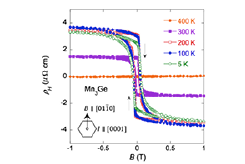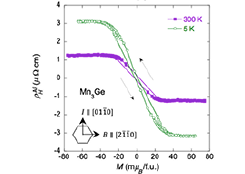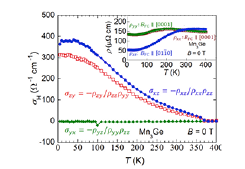Giant Anomalous Hall Effect in the Chiral Antiferromagnet Mn3Ge
Nakatsuji Group
Generally, the anomalous Hall effect is known to appear in ferromagnetic conductors and is proportional to its magnetization. Recently, however, the non-collinear antiferromagnet (AFM) Mn3Sn is found to exhibit a large anomalous Hall effect despite its vanishingly small magnetization [1]. The observation indicates that a large fictitious field or Berry curvature exists in the momentum space. The anomalous Hall effect shows a sign change upon reversal of a small magnetic field less than 0.1 T. The soft response of the AHE to magnetic field should be useful for applications, for example, to develop switching and memory devices based on antiferromagnets. In addition, an antiferromagnetic Weyl semimetal state is theoretically predicted by a band calculation [2]. The large AHE may well come from a significantly enhanced Berry curvature associated with the formation of Weyl points nearby the Fermi energy EF.

Fig. 1. Magnetic field dependence of the Hall resistivity in Mn3Ge measured in B//[0110].

Fig. 2. Magnetization dependence of the field- and magnetization-independent part of the anomalous Hall resistivity ρAFH = ρH − R0B − Rsμ0M at 5 and 300 K.

Fig. 3. Temperature dependence of the anomalous Hall effect under zero field. All the data are obtained at zero field after the field-cooling (FC) procedures made in the magnetic field BFC. Directions of the field BFC and electric current I used for the Hall resistivity measurements are shown in each figure.
Here we report another example of the AHE in a related antiferromagnet, namely, in the hexagonal chiral antiferromagnet Mn3Ge [3]. Our single-crystal study also reveals that Mn3Ge exhibits a giant anomalous Hall resistivity ρxz ∼ 4 μΩ cm, corresponding to a large Hall conductivity σxz ∼ 60 Ω−1 cm−1, at room temperature (See Fig. 1 and 2) [4]. The advantage of the measurements for Mn3Ge allows us to observe a giant AHE at low temperatures since Mn3Sn has a low-temperature noncoplanar magnetic phase observed at T < 50 K, where the in-plane AHE is strongly suppressed. As shown in Fig. 3, the conductivity in Mn3Ge is enhanced with decreasing temperature without any phase transition at low temperature and shows the approximately 380 Ω−1 cm−1 at 5 K in zero field, reaching nearly half of the value expected for the quantum Hall effect per atomic layer with Chern number of unity (Fig. 3). The low temperature conductivity σxz is estimated to be three times larger than the maximum of the conductivity found in Mn3Sn.
The observed giant AHE in the chiral antiferromagnet Mn3Ge with a very small magnetization indicates that the material has a large fictitious field (equivalent to be > 200 T) in the momentum space without producing almost any perturbing stray fields in the real space. The fact that the large fictitious field may be readily controlled by the application of a low external field indicates that the antiferromagnet will be useful, for example, to develop various switching and memory devices.
References
- [1] S. Nakatsuji, N. Kiyohara, and T. Higo, Nature 527, 212 (2015).
- [2] H. Yang, Y. Sun, Y. Zhang, W-J. Shi, S. S. P. Parkin, and B. Yan, New J. Phys. 19, 015008 (2017).
- [3] S. Tomiyoshi, Y. Yamaguchi, and T. Nagamiya, J. Magn. Magn. Mater. 31–34, 629 (1983).
- [4] N. Kiyohara, T. Tomita, and S. Nakatsuji, Phys. Rev. Applied 5, 064009 (2016).
